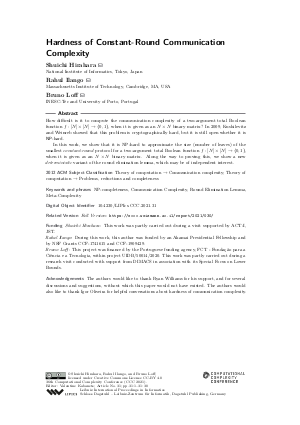@InProceedings{hirahara_et_al:LIPIcs.CCC.2021.31,
author = {Hirahara, Shuichi and Ilango, Rahul and Loff, Bruno},
title = {{Hardness of Constant-Round Communication Complexity}},
booktitle = {36th Computational Complexity Conference (CCC 2021)},
pages = {31:1--31:30},
series = {Leibniz International Proceedings in Informatics (LIPIcs)},
ISBN = {978-3-95977-193-1},
ISSN = {1868-8969},
year = {2021},
volume = {200},
editor = {Kabanets, Valentine},
publisher = {Schloss Dagstuhl -- Leibniz-Zentrum f{\"u}r Informatik},
address = {Dagstuhl, Germany},
URL = {https://drops.dagstuhl.de/entities/document/10.4230/LIPIcs.CCC.2021.31},
URN = {urn:nbn:de:0030-drops-143055},
doi = {10.4230/LIPIcs.CCC.2021.31},
annote = {Keywords: NP-completeness, Communication Complexity, Round Elimination Lemma, Meta-Complexity}
}

 Creative Commons Attribution 4.0 International license
Creative Commons Attribution 4.0 International license
































































